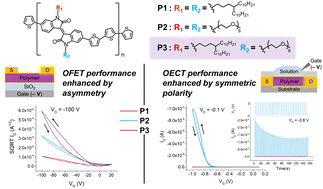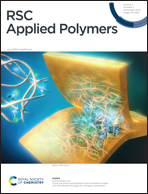Unravelling the influence of side-chain symmetry on device performance: insights from isoindigo-based polymers in thin-film transistors†
Abstract
Thin-film transistors are at the basis of next-generation electronics and bioelectronics, with functionality beyond that of traditional silicon-based devices. To move forward with emerging soft and human-integrated technologies, innovations not only in molecular design, but also in device engineering, are required to access improved performance, stability, and biocompatibility. In this study, π-conjugated isoindigo–bithiophene donor–acceptor polymers were designed and synthesized to possess different side-chain symmetries. Polymers possessing symmetric branched alkyl side chains, symmetric oligoethylene glycol side chains, or asymmetric side chains were synthesized, and their properties were evaluated in two types of thin-film transistors to examine the influence of side-chain design on key materials properties. The results from a multimodal characterization showed that the design of semiconducting polymers with asymmetric side chains can lead to materials with balanced optoelectronic and solid-state properties. The polymer designs exhibited differing levels of performance when implemented in each of the two types of fabricated transistors The properties of the polymer, including crystallinity, thin-film morphology, and swelling, impacted the material's performance in the organic field-effect and electrochemical transistors. While the asymmetric design was beneficial for charge transport in field-effect transistors, a highly polar and symmetric polymer, beyond the amphiphilicity of the asymmetric species, led to improved device characteristics in electrochemical transistors. Overall, this study uncovered insightful trends in the structures and device performance of conjugated polymers with different side-chain symmetries, thus informing new design strategies for a future of efficient, long-lasting biocompatible devices.


 Please wait while we load your content...
Please wait while we load your content...